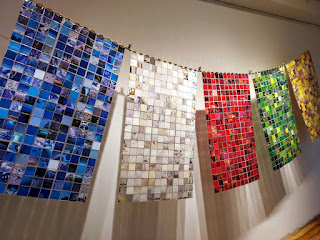Remember The Ladies
Here are three artists I adore—I love them so much I’d like to be them but, oh, right, I gotta be me. What I mean is, I look at their work and think, “Gee, I wish I’d thought of that.” But I didn’t, so I stick with what I do, inspired by all the different ways there are to make art.
First, Rest in Peace, Gloria Vanderbilt. She personifies this quote from Robertson Davies,
“Money can’t buy happiness but it allows us to endure unhappiness with exemplary fortitude.”
She endured unhappiness beyond what most of us can imagine and her fortitude was more than exemplary. She just kept on keeping on.
I love her aesthetic. I had trouble finding images of her paintings but she was often photographed in the midst of her creation. Like Aunt Connie, she made her home her magnum opus.
A wealthy woman who showed that money is nice but not everything, she was classy and not snobby—she’ll always be an inspiration.
Born into a wealthy Jewish family in Rochester New York she had rigorous academic training in Europe and at the Art Students League, where she also served on the board. Never married, she led a lively social life with her mother and two sisters. (Carrie Stettheimer created a magical dollhouse, decorated with tiny works of art by Marcel Duchamps and Gaston Lachaise. You can now see it at the Museum of the City of New York.) They were shut out of New York society because they were Jewish but created a circle of artists and intellectuals that was probably more interesting and fun than Mrs. Astor's 400.
Florine had one gallery show and didn’t enjoy the experience so decided to show her work in her own home—then wrote this poem:
First, Rest in Peace, Gloria Vanderbilt. She personifies this quote from Robertson Davies,
“Money can’t buy happiness but it allows us to endure unhappiness with exemplary fortitude.”
She endured unhappiness beyond what most of us can imagine and her fortitude was more than exemplary. She just kept on keeping on.
A wealthy woman who showed that money is nice but not everything, she was classy and not snobby—she’ll always be an inspiration.
Florine Stettheimer 1875-1944
Florine had one gallery show and didn’t enjoy the experience so decided to show her work in her own home—then wrote this poem:
Florine Stettheimer 1875-1944
Born into a wealthy Jewish family in Rochester New York she had rigorous academic training in Europe and at the Art Students League, where she also served on the board. Never married, she led a lively social life with her mother and two sisters. (Carrie Stettheimer created a magical dollhouse, decorated with tiny works of art by Marcel Duchamps and Gaston Lachaise. You can now see it at the Museum of the City of New York.) They were shut out of New York society because they were Jewish but created a circle of artists and intellectuals that was probably more interesting and fun than Mrs. Astor's 400.Florine had one gallery show and didn’t enjoy the experience so decided to show her work in her own home—then wrote this poem.
OUR PARTIES
Our Parties
Our Picnics
Our Bouquets
Our Friends
Have at last a raison d’être
Seen in color and design
It amuses me
To recreate them
To paint them.
Carl Van Vechten, noted art critic at the time, wrote, “The Lady had gotten into her art a very modern quality. A quality that ambitious American musicians will have to get into their compositions before anyone will listen to them. At the risk of being misunderstood, I must call this quality jazz.” You can see her work in the Whitney’s permanent collection and the Jewish Museum gave her a huge show in 2017. You can read about her in Peter Schjeldahl’s piece in the New Yorker: https://www.newyorker.com/magazine/2017/05/15/revisiting-florine-stettheimers-place-in-art-history
When I taught Art at Trinity School I often painted in the studio alongside my students. I did a series of large cheerful paintings and hung them in the cafeteria—flowers, vegetables, a swan, a rooster, all with checkerboard borders-appropriate for a room where children eat lunch. A friend said, “Jeez, where’s the angst? I thought artists were supposed to get drunk at the Cedar Tavern and beat each other up, throw paint around, cut off their ears, live a life of misery and die young. Your work is so ….nice.”
I took it as a compliment.
I don’t think I’m the only woman artist to hear that.
Red Rose Cantata, by Alma Thomas
I first encountered this painting in a staircase at the Museum of Modern Art. It’s 69” x 60”—bigger than me. I raced to the gift shop to buy a print and I’ve kept it on my bulletin board ever since.
The artist is Alma W. Thomas, an African American woman born in 1891 in Columbia Georgia. A graduate of Howard University she taught art until her retirement. She said, “The use of color in my paintings is of paramount importance to me. Through color I have sought to concentrate on beauty and happiness, rather than on man’s inhumanity to man.”
There was a gorgeous show of her work at the Studio Museum of Harlem in 2016.You can read about it here: https://www.artsy.net/show/the-studio-museum-in-harlem-alma-thomas.
Three extraordinary women, so different, so amazing.
They make me want to keep working.
|








Comments
Post a Comment